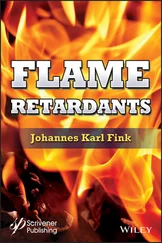Early work on the flame-retardant mechanism of red phosphorus in polyamide 6 suggests a mostly gas phase mechanism of action due to depolymerization into white phosphorus and volatilization in the oxygen depleted atmosphere of the pre-flame zone [27]. Later Levchik et al . [28] studied thermal decomposition of polyamide 6 flame-retarded with red phosphorus in nitrogen and found that phosphate esters are formed even in an inert atmosphere. Similarly, it was found that interaction of red phosphorus with PET leads to the formation of phosphate esters [29]. A more recent study also confirms an increased solid residue of polyamide 6.6 in the presence of red phosphorus [30]. Although an interaction of red phosphorus with traces of O 2and absorbed moisture [31] as well as H 2O formed during the thermal decomposition of the polyamide [32] is a possible explanation of the formation of phosphate esters, it is also possible that red phosphorus reacts directly with polyamide via a free radical mechanism as an electron spin resonance study suggests [28].
Despite the fact that red phosphorus is effective in both condensed and gas phase [33] it achieves V-0 rating only in nitrogen and oxygen containing heteropolymers, mostly engineering thermoplastics. In polyolefins, red phosphorus was found useful for a V-2 rating and a high limiting oxygen index (LOI) especially in polyethylene [34]. It is believed there is better match between the temperature of the thermal decomposition of polyethylene and the volatilization of red phosphorus compared to polypropylene [22]. It was shown that a V-2 rating at 1.6 mm could be obtained at a level as low as 2.5% finely divided red phosphorus (5 μm) [35]. Melamine-formaldehyde coating improves the efficiency of red phosphorus in polyolefins because it provides charring to enhance the flame-retardant effect of the phosphorus [36]. Although red phosphorus is not efficient alone in poly(acrylonitrile-butadiene-styrene) (ABS) it allows achievement of a V-0 rating at 8 wt. % loading when combined with 15 wt. % PET [37] or 8 wt. % magnesium hydroxide and 6 wt. % polyamide 6 [38].
Apart from thermoplastics red phosphorus finds applications in polyurethane foams, polyurethane elastomers [39], epoxy resins and textiles [40]. Typically, polyurethane foams are flame retarded with chloroalkyl phosphates, but in some applications where stringent fire tests are required red phosphorus can be used. For example, only 5 wt. % red phosphorus with 5 wt. % of melamine is required to pass the British BS 5852 Crib 5, furniture test [41] versus almost 20 wt. % of chloroalkyl phosphate combined with melamine. Red phosphorus combined with expandable graphite is used in automotive sound insulation foam under the hood [42].
In the mid 90s production of epoxy-molding compounds flame retarded by stabilized and coated red phosphorus for encapsulation of electronic devices started in Japan [43]. Because encapsulating epoxy is very heavily filled with silica only few percent of red phosphorus is enough to achieve a V-0 rating [44]. In the late 90s and early 2000s electronics manufacturers using red phosphorus containing molding epoxy started to receive massive recalls due to electronics failure. Further investigation showed that despite stabilization and coating, red phosphorus was still reacting with oxygen producing acids and phosphine which damaged semiconductor circuits [43]. In recent years more failures were reported in cables [45] and connectors [46] due to the presence of red phosphorus. Recently some electronics manufacturers announced a ban on red phosphorus in their products and resin manufacturers start reducing their red phosphorus-based lines of products. The only potential applications for red phosphorus in epoxy which are still being researched are light weight composites [47] and coatings [48].
2.4 Ammonium and Amine Phosphates
Because this Handbook has a separate chapter on Intumescent Flame Retardants (see Chapter 4of this book), in this chapter only a short overview of commercial intumescent FRs is given. Numerous academic publications on intumescent flame-retardant systems for polyolefins, elastomers and rubbers are out of the scope of this chapter. The broad subject of intumescent flame retardants was earlier discussed in a book [49], a number of reviews [50, 51] and a book chapter [52]. The mechanism of char formation in the pentaerythritol-ammonium polyphosphate (APP) systems was very extensively studied and described in great detail [53].
Water soluble monoammonium dihydrogen phosphate (MAP) and diammonium hydrogen phosphate (DAP) or short chain ammonium polyphosphate is the oldest class of flame retardants which are used on cellulosic materials such as wood, paper and cotton. A large volume of water-soluble ammonium polyphosphate is used in forest fire control, usually by aerial application, often in combination with ammonium sulfate. MAP and DAP can be applied to cotton or cotton-based blends by soaking, padding or spraying and then drying which will result in a FR finish non-durable for laundering. Non-durable finishes are most often used for disposable goods, for example medical gowns, party costumes, and sometimes wall covering. Ammonium phosphate finishes are resistant to dry-cleaning solvents but not to laundering or to leaching by water. However, some degree of durability of MAP can be achieved by combining with hydrophobic poly(methylhydrogen siloxane) or poly(dimethyl siloxane) [54]. Interestingly, cotton treated with MAP or DAP or water-soluble APP, urea and tauramine oxide and cured for 2 minutes at 170°C achieves durability of up to 15 washes [55].
Depending on fabric weight and density, 1-2% of phosphorus provides self-extinguishing performance and effectively prevents afterglow. Some organic co-additives can be added to the solution [56] to improve textile wetting and inhibit crystallization upon drying in order to avoid the formation of visible crystals of ammonium phosphates. Urea is used as a synergistic co-additive which helps to significantly increase the oxygen index and decrease char length as measured in ASTM D6413 flame test [57] and decrease the heat release rate [58]. Chitosan alone [59] or combined with sodium stannate [60] was also explored as a synergistic nitrogen source in combination with DAP. It was reported [61] that ammonium phosphates phosphorylate cellulose, which changes its mechanism of thermal decomposition suppressing the evolution of levoglucosan, a major fuel source, and increasing charring. It is also believed [61] that stannic oxide being a Lewis acid catalyzes the dehydration reaction of cellulose and increases char.
MAP and DAP combined with boric acid or other inorganic borates or sulfates are commonly used for flame retardant treatment of wood. Numerous formulations with water soluble phosphates for wood treatment can be found in the patent literature [62, 63]. Grexa and Utike [64] studied various inorganic flame retardants and their combination on particleboard using cone calorimeter and concluded that MAP and boric acid is the most efficient combination. In order to provide decay resistance to the wood treated with ammonium phosphates, apart from boric acid other antifungal additives can be applied [65]. Guanyl urea phosphate [66] or urea phosphate [67] in combination with boric acid are other systems for wood treatment which are somewhat less leachable than ammonium phosphate-based systems. Even more durable flame retardants applicable for outdoor use are achieved by the use of dicyandiamine and urea formaldehyde pre-condensates together with phosphoric acid and further polymerized after treatment [68]. DAP in combination with boric acid can be applied to paper which needs further treatment of the phenol-formaldehyde resole resin to preserve paper integrity [69].
Diguanidine hydrogen phosphate or monoguanidine dihydrogen phosphates are also used for non-durable cotton treatment [70]. These salts are particularly synergistic with 3-aminopropylethioxysilane [70]. Hexaammonium (nitrilotris(methylene))trisphosphonate ( Formula 2.1) is another water-soluble ammonium salt which is used in nondurable automotive and aircraft upholstery to minimize the effect on “hand” (texture).
Читать дальше












